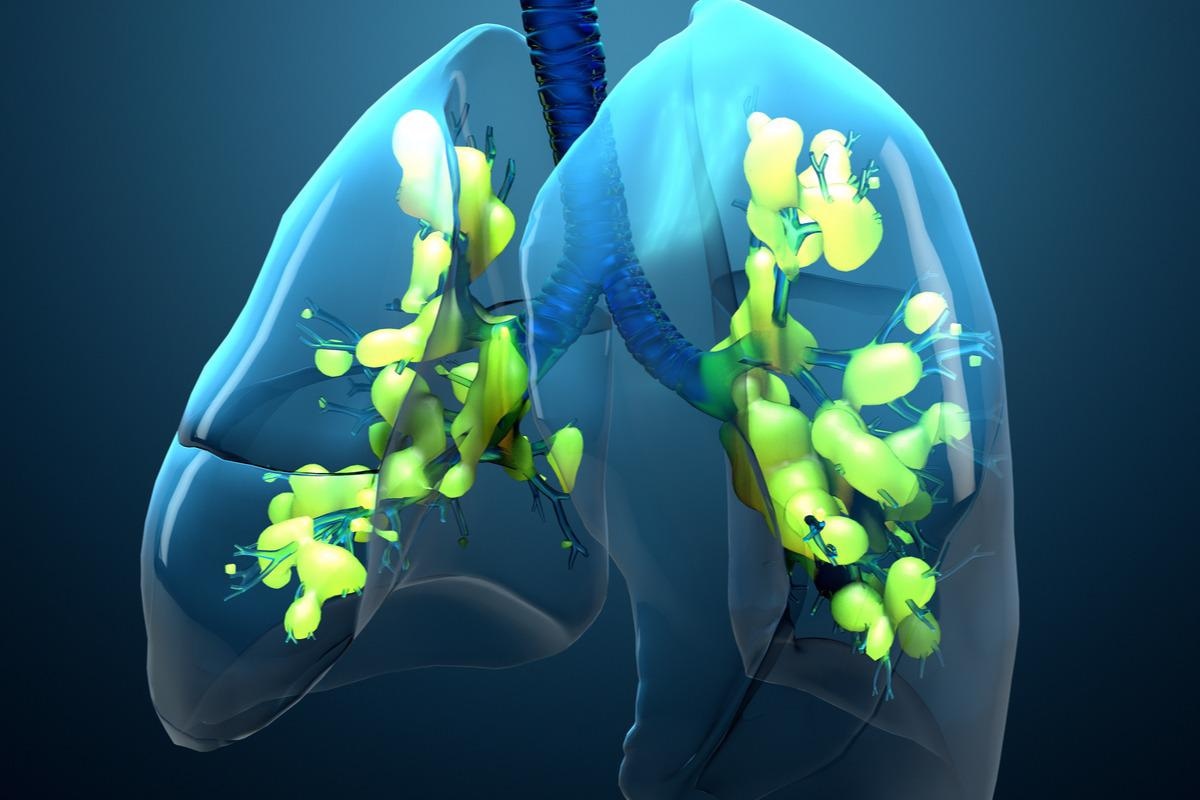In a recent study published in the Journal of Controlled Release, researchers developed 1,2-dimpalmiyristoyl-sn-glycero-3-phosphocholine (DPPC) liposomes co-loaded with methylprednisolone (MPS) and N-acetyl cysteine (NAC) to treat acute respiratory distress syndrome (ARDS) in vivo, as a model of acute pulmonary disorders.
 Study: Lung targeted liposomes for treating ARDS. Image Credit: Design_Cells/Shutterstock
Study: Lung targeted liposomes for treating ARDS. Image Credit: Design_Cells/Shutterstock
The researchers also compared the intravenous (IV) and endotracheal (ET) routes of delivery in this lipopolysaccharide (LPS)-based ARDS model.
Background
ARDS is an inflammatory injury of pulmonary tissues with mortality rates exceeding 40%. Glucocorticoids such as MPS have been widely used to reduce pulmonary inflammation. However, their prolonged and systemic administration causes severe adverse effects, such as interference with the wound healing and inhibition of effector cell function besides several myopathic, dermatologic, and cardiovascular adverse effects.
Thus, alternative treatment strategies are required. Therapeutic liposomes accumulate in inflamed lung tissues and thus hold potential for treating pulmonary disorders.
About the study
In the present study, researchers developed and assessed lung-targeted 100-nm liposomes for treating ARDS, as a model for lung diseases. The team also compared the ET and IV routes of liposomal delivery, or both routes simultaneously for treating ARDS.
First, liposomes composed of DPPC, cholesterol, and DSPE-PEG2000 (1,2-distearoyl-sn-glycero-3-phosphoethanolamine-N-methoxy-polyethylene glycol 2000) at a molar ratio of (60:35:5) were fabricated. Subsequently, MPS and NAC were sequentially loaded onto the liposomes. Liposomes were designed with 100nm size to improve their penetrability. The drugs, MPS, and NAC were encapsulated to reduce inflammation and improve mucosal penetration, respectively.
LPS (ET 5mg/ml, 20µL per mouse) was subsequently administered to induce inflammation in the lungs of C57BL/6 mice. Six hours post-inflammation, the liposomes were administered intravenously (IV, 200µL) and endotracheally (ET, 20µL).
After 60 minutes of liposome administration, the mice were euthanized, and lung samples were obtained and subjected to histological analysis. The team imaged the epithelial and endothelial sides of the pulmonary vasculature parenchyma on ET and IV administration, respectively.
Six hours post-LPS-induced inflammation, rhodamine-labeled liposomes (IV/ET) gadolinium (Gd)-loaded liposomes (IV/ET), Cy3-liposomes (ET), and Cy5-liposomes (IV) were administered to mice. Cytokines such as tumor necrosis factor-alpha (TNFα) and interleukins (IL-1α, IL-β, IL-6) were analyzed in bronchoalveolar lavage (BAL) fluid six and 26 hours post-LPS-induced inflammation and compared to healthy mice (controls).
In addition, mucosal penetration, the effect of the liposome-encapsulated drugs on RAW264.7 macrophages, and the efficacy of drugs incorporated into liposomes were compared to that of free drugs.
The in vitro liposomal uptake efficiency was examined using in vitro mucus permeation assays. In vivo, the LPS-induced lung inflammation model was used to evaluate the liposomal accumulation and efficacy by IV or/and ET routes of delivery.
Results
Drug concentrations of 1.1mg/mL and 4.3mg/mL for NAC and MPS were attained with encapsulation efficiencies of 92% and 98%, respectively. Drug-to-lipid molar ratios were 5 and 7.2 for NAC and MPS, respectively. The incorporation of NAC increased the liposomes’ mucosal penetration and thereby uptake by 1.8-fold.
The MPS and NAC drugs encapsulated into the liposomes reduced inflammation and mucus secretion in the inflamed lungs.
The inflamed lungs showed higher concentrations of the Gd-loaded and Rhodamine-labeled liposomes at all time points compared to the healthy lungs. This indicated that the ET liposomes accumulated more in the lungs compared to other organs.
However, IV liposomes accumulated in the lungs for an hour and declined thereafter. The IV and ET administrated liposomes reached the pulmonary endothelium and epithelium, respectively. Interestingly, the IV-delivered liposomes were distributed widely throughout the lung, while the ET liposomes were limited to lung parenchyma but absent in a few distal areas of the lungs.
Liposomal treatment had a superior therapeutic effect compared to free drugs in treating ARDS. This was indicated by the reduced levels of the IL-1β, IL-6, and TNFα cytokines in BAL fluid. The TNF-α levels were also reduced in treating the RAW 264.7 macrophages.
Conclusion
Overall, the liposomes reduced pulmonary cytokines levels and the secretion of chemical mediators that induce inflammation.
Importantly, the IL-6 levels substantially decreased on combined delivery viz. ET and IV (664 pg/ml) in comparison to the untreated animals (2962 pg/ml). Likewise, TNF-α levels also substantially decreased following combined delivery (540 pg/ml) compared to the untreated animals (1459 pg/ml). The IL-1β levels were five-fold lower by combined delivery.
To conclude, according to the study findings, the administration of MSC and NAC drug-encapsulated 100 nm DPPC liposomes administered via ET and IV routes simultaneously yielded the best treatment outcome for ARDS.